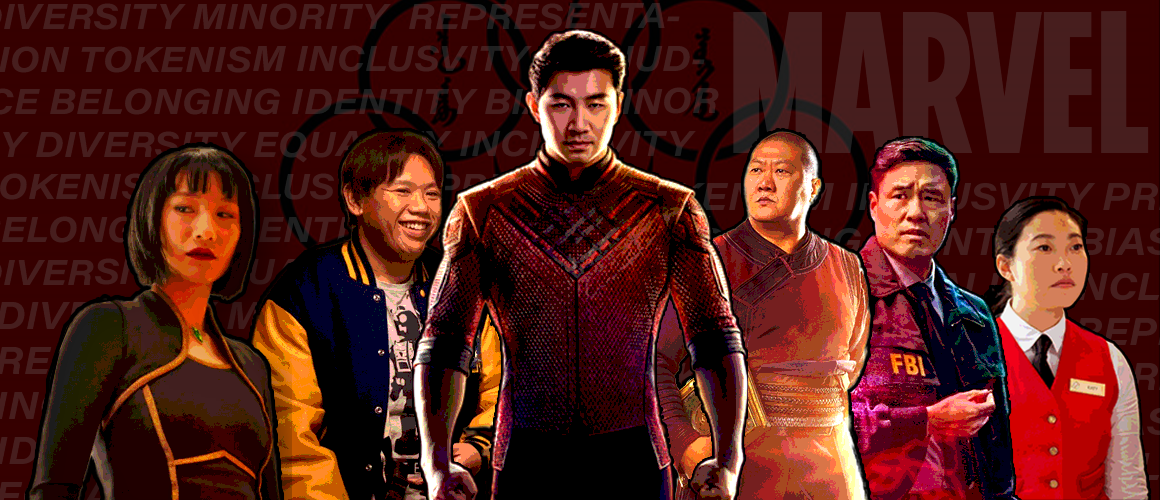Listen to the Story:
This past December, I was sitting with 15 family members and friends at the movie theatre on the opening night of Spider-Man: No Way Home — something we had been looking forward to for a whole year — when a very unexpected scene came on screen. Ned, Spider-Man’s best friend, and M.J, Spider-Man’s girlfriend, sit at his grandma’s table.
Although the movie was brand new, the scene looked familiar to me — the tables, the wallpaper, the picture frames, the displays, the small details that maybe others wouldn’t notice. But my cousins, friends, and I did. We noticed, and my cousins began eyeing me from down the theatre’s aisle.
“Are they eating pandesal [a Filpino bread]?” my other cousin to the right of me whispered.
I looked to my left, and my partner nodded to confirm, yes, we were all seeing the same thing — a Filipino house on the IMAX screen. Ned’s lola (grandma) appeared on screen, and I could see everyone’s eyes light up. The set looked like it could have belonged to my lola. It was incredible.
The Underlying Issue
Although Marvel Cinematic Universe (MCU) is the world’s biggest cinematic franchise, grossing over $25 billion worldwide, it has only recently begun including more diverse characters. Many communities — women, people with disabilities, ethnic minorities, and people who identify as 2SLGBTQ+ — lack representation in the MCU. And even when these groups are included in Marvel films, they are often tokenized. According to Forbes, in the MCU, 61 per cent of characters are white, 20 per cent are black, 8 per cent are multiracial, 5 per cent are East Asian, and 1 per cent are South Asian.
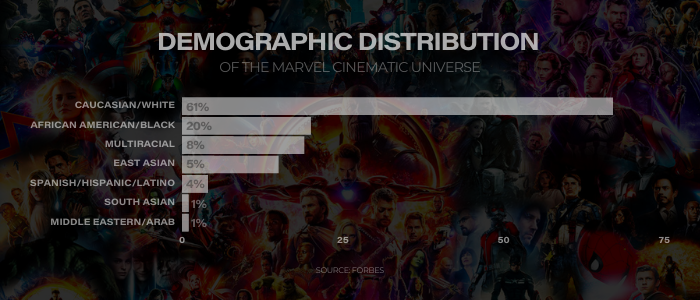
But Marvel’s fandom is growing rapidly, and fans using platforms like TikTok are demanding more diversity while also celebrating new diverse superheroes like Shang-Chi from their 2021-released Shang-Chi and the Legends of the Ten Rings.
The MCU isn’t the only studio with this problem. It’s rare to see Asians on the big screen period. A study from the USC Annenberg School for Communication and Journalism found that Asian and Pacific Islanders accounted for less than six per cent of speaking roles in Hollywood and less than four per cent of leads were Asian and Pacific Islanders (API) .
After the film, Black Panther’s cultural impact and commercial success in 2018, Marvel’s president, Kevin Feige, told Variety’s Playbook podcast that diversity would be the focus of upcoming MCU movies, something that Marvel’s online community has been calling for for quite a while already.
Marvel’s Online Community
TikTok is where many old and new fans are having conversations about the future of the MCU and the issues surrounding diversity in its films. There are more than 137.3 billion video views under the hashtag #Marvel on TikTok.
Many fans also dedicate their time to creating Marvel content for Marvel-focused podcasts, blogs, and YouTube channels. Among those streams of online Marvel content is a podcast called the Voices of Atlas, hosted by three Asian-Canadians, Victoria Organa, Laiba Hazara, Jonathan Chou, and one Asian-American, Nick Castillo. They come together to discuss everything Marvel and Asian representation in Marvel.
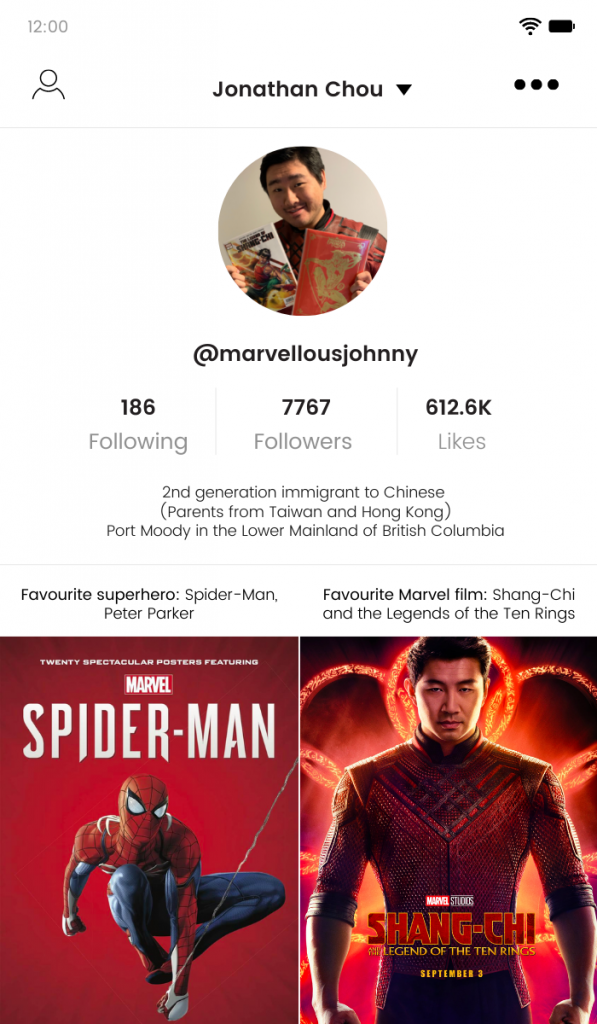
About Jonathan
“I am a Zellenial whose aspirations in life are to make some form of positive impact in the world, whether it be through helping people one by one or through systematic changes. Thus my motivation to gain a degree in criminology while also becoming a content creator on the side to help push for a positive narrative for the AAPI community.”
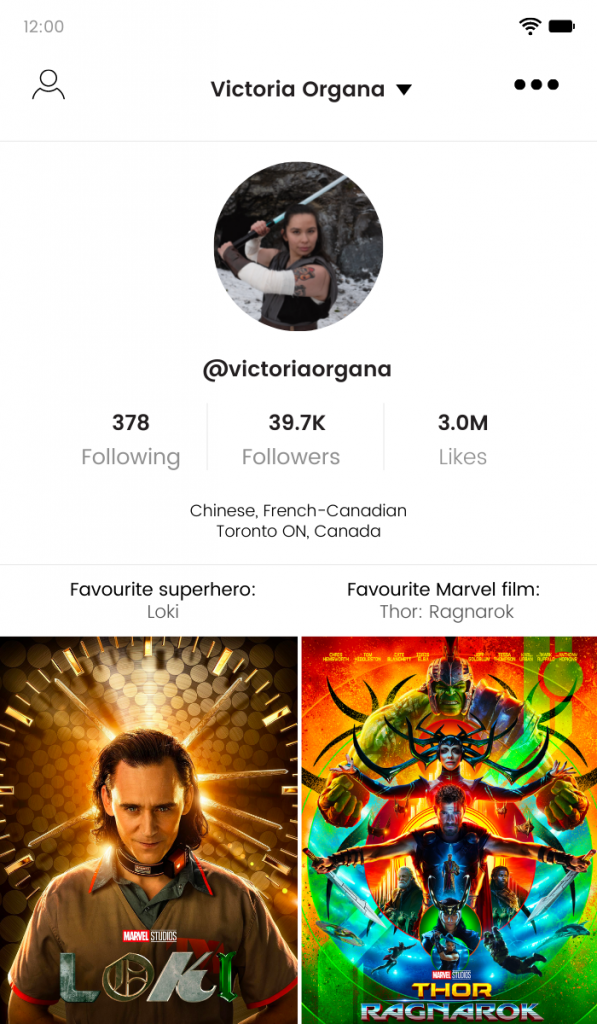
About Victoria
“Victoria loves to geek out in both their personal and professional life, spending her days working in technology, and her evenings making tiktoks on everything super hero and Star Wars related. With a passion for diversity in media, she spends her time advocating for racial, queer, and neurodivergent representation on their own platform and on the Voices of Atlas podcast.”
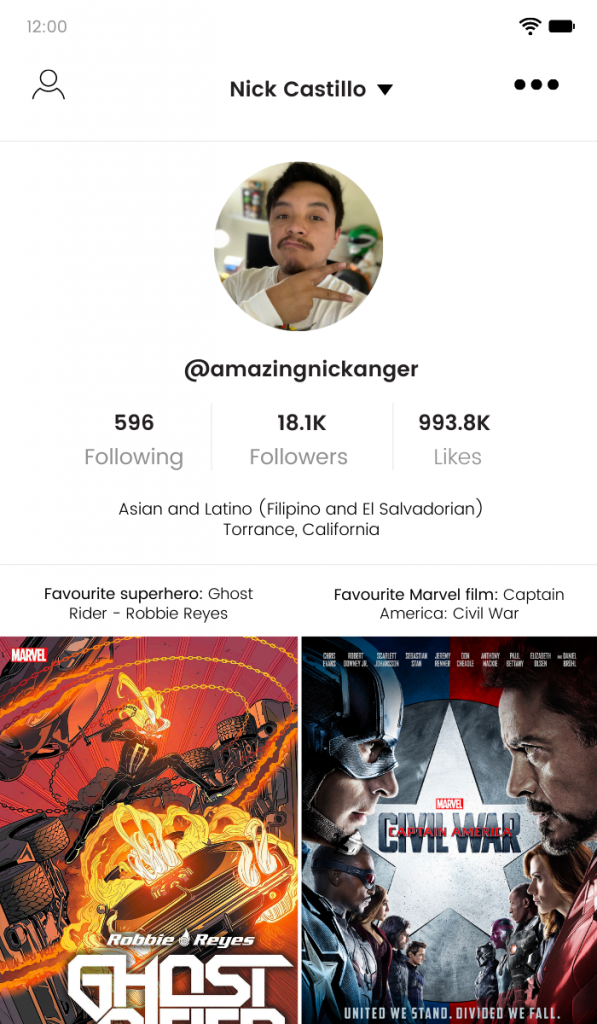
About Nick
“I am a freelance illustration and lead artist of the Voices of Atlas! I use the stories I love to fuel my creative outlet and give back to the communities I’m a part of.”
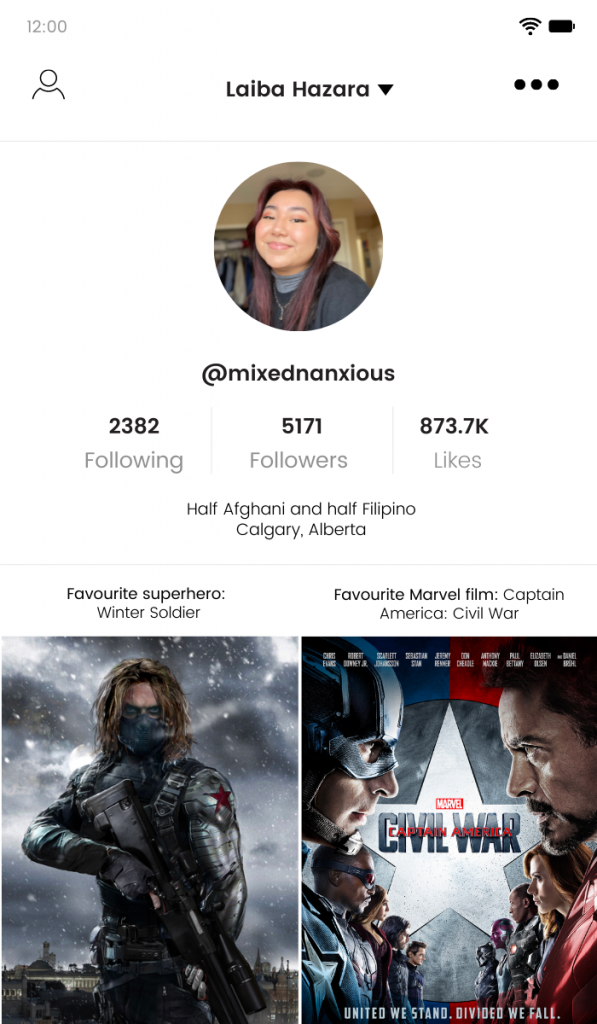
About Laiba
“I am an aspiring filmmaker and actress that is all about telling more stories with proper representation. Being a content creator with a podcast allows me to talk about representation and how we need more of it.”
Voices of Atlas
The members of Voices of Atlas met through the online Marvel TikTok community. They were strangers up until the release of Shang-Chi and the Legends of the Ten Rings. They all have relatively large social media followings and a similar fan base and became friends interacting with each other’s TikTok live streams and commenting on each other’s videos. They bonded through their love for Marvel and their Asian ethnicities, eventually creating Voices of Atlas.
Jonathan Chou, 23, from Vancouver, British Columbia, is one of the hosts on the Voices of Atlas. He’s a Marvel fan and TikTok content creator, also known as @marvellousjohnny on TikTok.
Chou says they came up with the name Voices of Atlas because of Marvel’s comic series called Agents of Atlas, a group of Marvel Asian superheroes.
The “voices” aspect of the name comes from a Marvel comic titled Marvel’s Voices, which is their line of comics for marginalized groups, such as 2SLGBTQ+, Latino, Indigenous Peoples, and more.
The hosts created this podcast as a safe space to speak about the MCU and their takes on diversity in Marvel films. They believe it’s important to be loud and take up space to talk about representation and change.
“That’s the only way that we’ll be able to get the kind of representation out there and show there’s a market,” says Victoria Organa, one of the hosts on the Voices of Atlas.
Nick Castillo from Torrance, California, another host from Voices of Atlas and TikTok creator with over 17 thousand followers, says they always try to have fresh, diverse perspectives, even when choosing guests to come on to the show.
Castillo made the deliberate choice not to invite white men on the podcast. Instead, he wants to amplify diverse voices. He says if they’re going to talk about diversity, they should also practice it.
“There’s a million podcasts where you go listen to those [white] guys. And this is not their space to do it. It’s not that we hate them. It’s just that we want women here, and we want people of colour here. We want queer people here. Because they don’t usually exist in other [Marvel podcast] spaces.”
The primary purpose of their podcast is to make people feel included and be relatable to personal stories and experiences.
“It’s for anyone who ever feels like they aren’t heard or that they don’t feel seen. They feel silenced. I think it’s an environment where you really just want people to feel included,” says Chou.
Shang-Chi and the Legends of the Ten Rings
For the first time in Marvel history, Asian heroes dominated the big screen in 2021 with the release of Shang-Chi and the Legends of the Ten Rings.
Before Marvel released the film in 2021, Chou says he wasn’t entirely sure if the film would succeed.
He was skeptical of the film because of how problematic Marvel Shang-Chi’s character was in the 1970s.
“I read the first comic book [Shang-Chi] digitally, and it straight-up starts with a white man calling Shaun [Shang-Chi] a Chinaman and then critiquing his father with his cat eyes, yellow skin, and long nails. So, from that alone, I was not looking forward to it.”
Chou says he was hesitant because of the comics’ harmful stereotypes about the character. At the time, he believed that’s how the film would play out.
“They got the really good-looking Canadian-Chinese dude to play Shaun. But at the same time, I was still scared that they were going to typecast him.”
Being a new actor, Simu-Liu was only known for the T.V. series called Kim’s Convenience before landing his role in Shang-Chi and the Legends of the Ten Rings.
Chou felt scared that actor Simu Liu would be a “yes man” who would agree to whatever they wanted, including portraying certain stereotypes.
Impact of Diversity and Representation
When Chou finally watched Shang-Chi and the Legends of the Ten Rings, it exceeded his expectations and ultimately became his favourite movie.
“I rented out a movie theatre for the Friday of the premiere with twenty of my closest friends.”
Chou grew up in a Chinese family in British Columbia, and his parents sent him to a predominantly Chinese private school in Canada. He grew to resent his own identity as he failed to meet specific Chinese cultural standards. He also didn’t have many friends growing up and was often bullied by others around him and ended up resenting his identity even more.
“I just grew more and more in the sense that I was more white on the inside than I was Asian. But since this movie came out, I’ve wanted to learn more about my own culture and everything.”
Chou felt a solid connection to the character Shang-Chi and actor Simu-Liu because he too is a westernized Chinese person living in Canada. Chou finds that he also has a similar relationship with his father, as Shaun does with his father in the film.
“Shaun’s dad’s reaction felt very relatable for me – because growing up, my dad was relatively an angry person. During Shaun’s final confrontation with his father in the film – Shaun was screaming back at his father of what he had become as a by-product of his father’s actions and choices — this resonated with me because I’ve in some way adopted my dad’s aggression.”
He says the film shows some of the negative sides of Chinese culture, especially the concept of the man of the house.
The film also impacted Castillo, who is Filipino-El Salvadorian.
“To see an Asian person — to see a part of me be on screen was enough for me to feel like this is game-changing for me.”
Castillo emphasizes that he still loves the original classic heroes like your friendly neighbourhood Spider-Man, who has been a comfort character for years to fans through his relatable awkward teenage personality.
“As much as I love Spider-Man, I feel like the character’s outdated in a sense because there are so many more characters now that are much more relatable, in terms of not just myself, but for other cultures. Now you have very particular characters that make you feel even more empowered, and that is important.”
Could seeing relatable characters onscreen be a sign that the MCU is finally moving beyond tokenism?
Harmful Tokenism & Negative Character Tropes
The White Hero and the Sidekick of Colour
War Machine and Iron Man, Falcon and Captain America, Ned and Spider-Man, Wong and Doctor Strange, Luis and Ant-Man, Maria Rambeau and Captain Marvel, and Valkyrie and Thor. Do you happen to notice a pattern here? It’s always the same thing: a white hero and a sidekick of colour. It’s easy to identify this character formula used in many Marvel and Hollywood films once you’re aware of it.
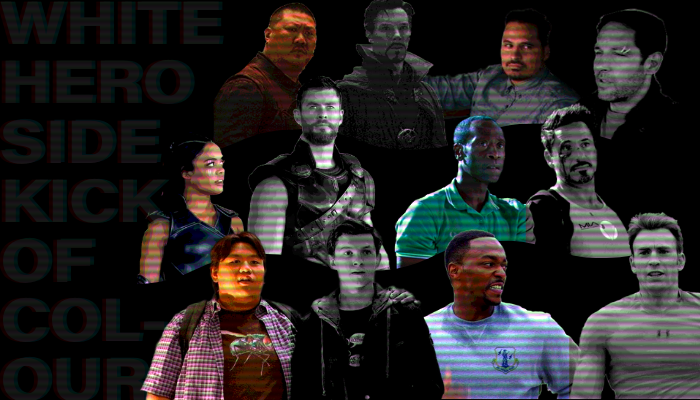
Acknowledging tokenism and understanding how it perpetuates harmful stereotypes can help viewers understand what they’re truly seeing.
In addition to race, viewers might also notice a difference between the social class of heroes and sidekicks. An example of this is Falcon, also known as Sam Wilson, who lives in debt and runs a counselling group for veterans who struggle with PTSD. His partner, Captain America is the face of the nation whom everyone loves and adores. They have completely different lifestyles. In most of these films, we only see a glimpse of these side characters’ lives, but it’s enough to know they are not living in luxury like the heroes.
Marvel sidekicks are known to be silly. Some online Marvel communities point out that the humour is usually carried by stereotypes.
Castillo says the side characters in the MCU films are great, and everyone loves them; however, there’s a fine line between regular character tropes and stereotypes.
Being half-Latino and half-Filipino, Castillo feels strongly about these stereotypes. For example, in the Ant-Man films, Luis, Ant-Man’s best friend, is played by Michael Pena, who portrays a stereotypical character.
“I like Luis, and I think he’s great. But he’s not a perfect character. He’s still living a stereotype. This idea, like ‘Oh, haha, funny Latino man. Funny Spanish man who talks really fast.’ And as a Latino person, that kind of sucks. That’s half of my identity and it’s just kind of the butt of a joke.”
Castillo also questions Ned’s character in the Spider-Man films.
“I’m Filipino, and Ned’s Filipino. And it sucked to see him in [Spider-Man] Far From Home be like this side subplot that was not really important or significant. Was it funny? Sure. It was funny. Did it have to be Ned? I don’t know that. I don’t think so.”
Asian Americans and people of colour (POC) have often been used for comic relief, and films often use them as the punchline.
“It’s just embedded into seeing white actors being the centre of the screen. They’ve [POC] always been complements to the story at hand. And it’s something I didn’t really think about because again, I grew up on American television, and I grew up in American filmmaking, and it’s like, okay, ‘well, that’s just normal, right?’”
Castillo appreciates American films for what they are. He understands actors like Jackie Chan and Chris Tucker playing these racial stereotypes in Hollywood films like the famous Rush Hour franchise in the late 1990s.
“You can enjoy it. But we can’t just walk away from and be like ‘yeah, you know what, let’s keep doing that. Let’s keep these really toxic stereotypes and continue making that,’ because that’s just not how the world works anymore. You can’t get away with that kind of stuff anymore.”
According to a study by Geena Davis Institute on Gender in Media, CAPE and Gold House, 35 per cent of API actors in films say their characters embody one common stereotype like the “Martial Artist,” “Model Minority,” or “Exotic Woman.”
Organa, one of the hosts of Voices of Atlas from Toronto, Ontario, talks about harmful character tropes and stereotypes in the newly released Marvel shows like WandaVision and Loki.
Whitewashing Characters — Doctor Strange (2016)
In 2016, Doctor Strange made his debut in the MCU. There was controversy during the release of this film around the character called the Ancient One. Marvel had received significant backlash when they announced the actress who would play the character — Tilda Swinton.
The controversy was that the Ancient One was initially East-Asian in the comics; however, the actor who plays her, Swinton, is white. When you erase that kind of identity from a prominent character, you should expect a negative response.
Chou says this is one of the bigger missteps in the MCU.
“They originally wanted to make the Ancient One Tibetan. They couldn’t have made them be Tibetan because there was this whole issue with China’s censorship around that, which is unfortunate. But their way around that was by just casting a white woman, which even Kevin Feige has admitted to it being a misstep and oversight in their eyes that they wish they could change.”
Chou believes Swinton did a fantastic job, and she did represent women in her role.
“But at the same time, it came at the cost of Asian representation.”
Is the MCU obligated to include diverse characters?
The central theme surrounding the last two years of the MCU films is diversity. Marvel Studios is making an effort to represent racial identities, 2SLGBTQ+ voices, and people with disabilities. It’s been a success and an ongoing conversation in the media and the Marvel community. But the question is, is the MCU obligated to include diversity, especially people of colour? Is it their responsibility?
Chou believes if a big company like Marvel includes and creates themes around diversity, they must put effort into doing it right.
“We should fight for ourselves. We should appreciate the people who fight with us, and we should appreciate the media that does support us.”
Castillo says large companies like Marvel and Disney aren’t obligated to fight this battle, but since they are, they should do it with respect and accuracy.
“If you’re gonna take diversity on, if you’re gonna take race on, if you’re gonna take queer representation on, you have to take it as a whole,” says Castillo.
Castillo emphasizes the impact people of colour can make on the future of film.
“You’ve got literally like 150 years of filmmaking to make up for. You can’t solve it in one film. I’ll never see the results of that in my lifetime. I’ll never see the perfect world of diversity that I live in that I’m fighting for now. It’s as sad as it is, and I’ll never see it. Does that mean I stopped fighting for it? No, absolutely not. I just have to hope that what I’m doing is meaningful for somebody as it is meaningful for people around me.”
Behind the Scenes
While there has been some progress, however slow, in having diversity on screen, things are even worse behind the scenes.
According to a study by the USC Annenberg School for Communication and Journalism, only 2.5 per cent of 3593 credited film producers were API.
Having diverse people working in behind-the-scenes roles, from directors to crew, is essential for meaningful diversity. If Marvel is serious about diversity, they must include diverse perspectives in all parts of the process. The decisions that shape even the most minor aspects of a film, should come from a variety of points of view.
“The directors need to be people of colour, and the writers need to be of different ethnicities and different walks of life. The deeper we get into the production side, the faster change you’ll see,” says Castillo.
Shang-Chi and the Legends of the Ten Rings had a very diverse production crew. Director Destin Daniel Cretton and screenwriter David Callaham are both Asian-American and paid close attention to detail while on the set of Shang-Chi. They articulated the importance of accuracy and looked at the authenticity of the stories. In the film, the fight scenes were exceptionally well choreographed and used authentic Chinese Kung fu — Wing Chun, Tai chi, and Shaolin.
Since the film follows a westernized Asian-American standpoint, it was important to the director and writers to have those perspectives.
Hazara is a half-Afghani and half-Filipino film student from Calgary, Alberta. She talks about the importance of having a diverse cast and crew.
How Marvel Continues to Evolve
As the Marvel films evolve, we see less harmful tokenism. Shang-Chi and the Legends of the Ten Rings did not include any insensitive racial stereotypes like Asian men being unmasculine, passive, or good at math.
The writers made Shang-Chi strong and assertive. They even took a step and deconstructed the stereotype of Asian women as villains. Historically, in Hollywood films, Asian women who are the antagonist or villains are overly sexualized and fetishized, but Shang-Chi and the Legends of the Ten Rings had nothing like that.
Chou is very excited about the direction of inclusion the MCU is stepping in.
“They’re so big now, and all eyes are on them. For [Marvel] to give people who don’t have that representation the attention they deserve. It’s amazing.”
In the future, the MCU will be introducing a new character, Ms. Marvel, also known as Kamala Khan, a 16-year-old Pakistani American from Jersey City. Fans are thrilled to finally have a South Asian teenage girl in the MCU.
The MCU has also introduced characters like Monica Rambeau from WandaVision, and will soon be introducing America Chavez as Miss America, the world’s first Latinx superhero in the MCU.
Marvel continues to impact families all over, including mine.
Back in that theatre with my family and friends, the scene continues, and (spoiler alert) one of the most iconic scenes in the MCU unfolds. Andrew Garfield, an actor that previously played Spider-Man before Tom Holland enters Ned’s lola’s house through Ned’s portal, and Ned’s lola begins speaking Tagalog (a Filpino language).
Is this really happening right now? Is Andrew Garfield really in this movie? And is Ned’s lola really speaking Tagalog right now?
The theatre explodes with energy and excitement. This is the moment the audience has been waiting for — Toby Maguire, the predecessor to Andrew Garfield appears. The multiverse is real. Ned’s lola continues to speak in Tagalog, and my cousins and I cheer her on. I’m overwhelmed.
I look back over my shoulder at my younger cousins, who are only seven, nine, and eleven. They are hearing the language they grew up speaking on the big screen. The look of shock on their face is priceless. How would seeing something like this have impacted me as a Filipino kid?
For five minutes and 10 seconds, the whole world experienced two generations of Spider-Man sitting in a Filipino home. People will be talking about this scene for years to come. I couldn’t wrap my head around it. The most popular movie in the world right now has Filipino representation. Even if it was just five minutes and 10 seconds of representation, it was five minutes and 10 seconds I’ll never forget.
